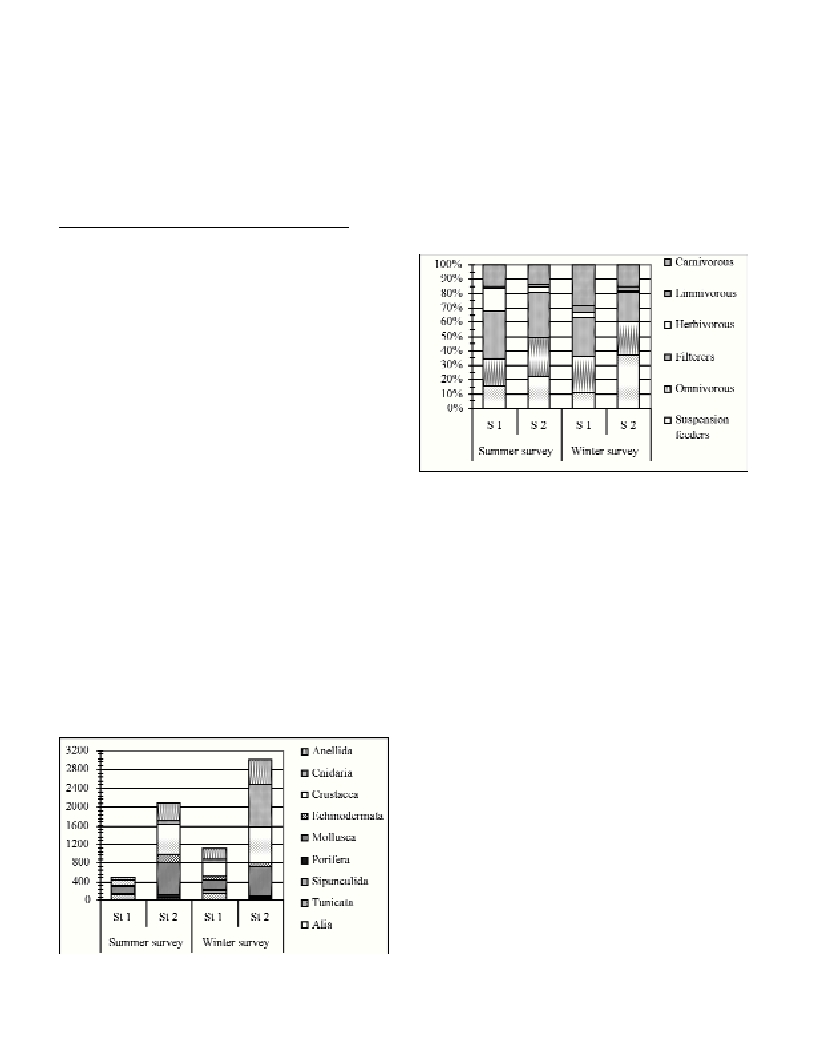BENTHIC COMMUNITIES OF ROCKY OUTCROPS IN THE NORTHERN ADRIATIC SEA:
A QUANTITATIVE SURVEY
S. Soresi, A. Cristofoli, L. Masiero, S. Casellato
*
Benthos Ecology Laboratory, Dipartimento di Biologia, Università di Padova, Italia - * sandra.casellato@unipd.it
Abstract
A total of 12 samplings, carried out between August 2002 and May 2003, by SCUBA diving, produced much data regarding the physical-
chemical environment and the benthic communities of two rocky outcrops, 20 m deep, opposite Chioggia in the Gulf of Venice, Italy. Little
data has been available regarding the ?oral and faunal communities of this environment. The richness of the community, and the high
population density observed in the explored areas, highlight their importance as biodiversity oases in the northern Adriatic Sea.
Keywords: Adriatic, rocky outcrops, benthos, composition
Rapp. Comm. int. Mer Médit., 37,2004
551
Introduction
The northwestern Adriatic seabed is characterized by soft sedi-
ments, from mud and silt to sand. Even though reports of rocky out-
crops have been made since 1792 (1), their underwater exploration
begun only in 1967 (2-6).The numerous outcrops differ from the
rocky matrix of the continental plate, and vary in size, distance from
coast, and depth, ranging from 10 to 40 m. They may have originated
by the cementing of the pebbly foreshore sediments in the waterline,
between 3000 and 4000 years ago (7), or through methane surfacing
through sediments (8). The erosion processes uncovered these out-
crops, which were subsequently colonized by marine organisms. The
encrusting biota incorporates sediment and shells, and itself becomes
a substrate for other organisms. Thus complex coralligeneous struc-
tures evolve, overgrowing the rocky matrix and simulating reefs. The
ecological role of these coralligeneous structures in the northern
Adriatic is extraordinary, because, in addition to providing a solid
substratum for benthic organisms, they introduce environmental gra-
dients in the monotony of the Adriatic’s soft bottoms, generating dif-
ferent ecological niches. Till now, these environments have been only
partially studied (9).
Results and Discussion
270 species have been identified from our seasonal samples. Some
are new records for the Mediterranean, and one species is new to sci-
ence; their population density varied between 479 and 3022 ind/m
2
(Fig.1). Marked differences were observed between the two out-
crops, related both to different water turbidity, and the distance from
the coast, and to the different origin. The filter feeders and suspension
feeders (Fig.2) predominate; the algae are restricted to few species of
Rodophyceae and Corallinaceae. The Shannon-Index values, between
3,44 and 3,57, are much higher than those reported for neighbouring
communities on soft sediments (10).
These outcrops represent a high diversity “oasis” in the North
Adriatic, and their peculiar communities present characteristics inter-
mediate between the biocenosis of coralligenous platforms (11) and
the biocenosis of shelf edge rock (12).
Fig. 1. Quantitative faunistic composition of the two outcrops.
Fig. 2. Feeding guilds composition of the benthic communities of the two
outcrops.
References
1-Olivi G., 1792. Zoologia Adriatica, Bassano.
2-Stefanon A., 1969. First notes on the discovery of outcrops of beach
rocks in the Gulf of Venice (Italy). Rapp. Comm. Int. Mer. Médit., 19 (4):
649.
3-Stefanon A., 1970. The role of beachrock in the study of evolution of
the North Adriatic Sea. Mem. Biogeog. Adriat., 8: 79-99.
4-Stefanon A., 1972. Beach rocks and Paleogeography in North Adriatic
Sea. Rapp. Comm. Int. Mer Médit.(4): 606-608.
5-Newton R.S. and Stefanon A, 1975a. The “Tegnue de Ciosa” area:
patch reefs in the Northern Adriatic Sea. Marine Geology, 19: 27-33.
6-Newton R.S. and Stefanon A, 1975b. Application of Side-scan Sonar in
Marine Biology Mar. Biol., 31: 287-291.
7-Braga G. and Stefanon A., 1969. Beachrock e Alto Adriatico: aspetti
paleogeografici, climatici, morfologici ed ecologici del problema. Atti Ist.
Veneto Sci. Let. Ed Arti, 127: 352-361.
8-Stefanon A. and Zuppi G.M., 2000. Recent carbonate rock formation
in the Northern Adriatic Sea: hydrogeological and geotechnical
implications. Hidrogéologie,4: 3-10.
9-Gabriele M, Bellot. M., Gallotti D., and Brunetti R., 1999. Sublittoral
hard substrate communities of the Northern Adriatic Sea. Cash. Biol. Mar.,
40: 65-76.
10-Casellato S., Masciadri S., Masiero L., Campi G., 2002. Impact of the
hydraulic dredge on the benthos community of the North-western Adriatic
coasts. Biol. Mar. Med., 9: 170-179.
11-Sarà M., 1971. Le peuplement du coralligène des Pouilles. Rapp.
Comm. Int. Mer. Médit.30 (3): 235-237.
12-Gamulin Brida H., 1974. Biocenosis benthique de la mer Adriatique.
Acta Adr., 15 (9): 1-102.

